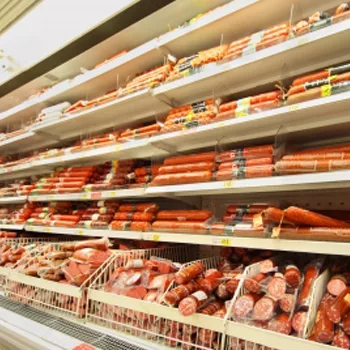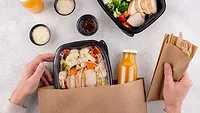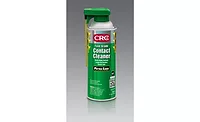Selecting Seals for Global Food-Contact Applications

It is not unusual today for sealing components to be used halfway around the world from where they were manufactured. There are certain commonalities in global food-contact regulations, but also significant variations. While U.S. and E.U. predominate, more than 30 countries have such regulations—all of which prohibit the sale of food-contact articles and materials that transfer chemicals to foods in concentrations hazardous to health or that adversely affect the sensory (organoleptic) properties of food. In addition they all specify the use of manufacturing Practices (GMPs) in the production of these products.[1]
The consequences of noncompliance can be draconian—fines, imprisonment or both. Therefore, it’s important to select the right sealing component for where it will be ultimately used.[2] Compliance with the applicable regulations does not necessarily mean a seal is appropriate for its intended use. Selecting a sealing component for a food-contact application is done in the same manner as selecting a seal for any application, taking into account the forces acting on it.[3] For a static seal, this begins with defining the gasket stress and system pressure. The stress must be sufficient to provide an adequate seal, but not so high as to crush or extrude the gasket into the process media. For a dynamic seal, this involves not only the system pressure, but also surface speeds, mating surface conditions and run-out.
For both static and dynamic applications, the typical and maximum temperatures involved and the media being sealed must be identified. Suitable sealing performance might be achieved at these temperatures, but a substance in the sealing material could thermally degrade, producing undesirable by-products. This is of particular concern with regard to fiber sheet compositions, which are often rated for temperatures that can severely degrade their binders, generating potentially toxic decomposition products.
It is also important to determine if there are any cleaning procedures involved, such as clean-in-place or steam-in-place regimes, and whether the surface morphology of the sealing material will permit adequate cleaning.[4,5] Global regulations concerning food contact materials focus largely on chemical substances that can leach out and migrate into the food.
Another issue is the sealing component physically entering the food. For a static seal this may result from intrusion of the gasket into the process stream. For a dynamic seal it may be the result of excessive wear. For both static and dynamic seals, thermal or chemical degradation may cause fragmentation. While the risk of this occurring can be minimized by proper material selection and seal design, it cannot be totally eliminated. There are also instances where the entire sealing component may enter the food due to mishandling or improper installation.
The U.S. Food and Drug Administration’s (FDA’s) Food Safety Modernization Act Preventive Controls for Human Food rule is now final, and compliance for some businesses began in September 2016. Covered facilities must establish and implement a food safety system that includes an analysis of hazards and risk-based preventive controls. As part of these controls, many facilities utilize metal or X-ray detection systems. Sealing components are available that can be detected by one or both techniques.[6,7]
U.S. Regulations
In the U.S., sealing products for food applications are regulated by FDA, who considers them to be food-contact articles made of food-contact materials (FCM). These typically consist of a mixture of Food-contact Substances (FCS). An FCS is considered an indirect additive if it comes into contact with food as part of the packaging, holding or processing. However, it is not intended to be added to, become a component of, or have a technical effect on it.
Regulations regarding indirect additives are found in Title 21 of the U.S. Code of Federal Regulations (21 C.F.R.). The two most common regulations pertaining to sealing products are 21 C.F.R. 177.2600 (rubber articles intended for repeated use) and 21 C.F.R. 177.1550 (perfluorocarbon resins).[8,9] 21 C.F.R. 177.2600 is essentially a list of permitted base elastomers, vulcanization materials, accelerators, retardants, activators, antioxidants, plasticizers, fillers, emulsifiers and other additives. The list also recognizes some materials as inherently safe, which are classified as Generally Recognized as Safe.
21 C.F.R. 177.2600 also includes restrictions on the level of substances permitted. The permitted level of some substances is linked to the type of food. For instance, the level of channel or furnace carbon black is less than 50 percent for nonmilk/edible oil contact. However furnace black content for milk and edible oils is limited to less than 10 percent.
In addition, 21 C.F.R. 177.2600 sets product extraction limits for both aqueous and fatty foods. Extractables in fatty foods must be less than 175 mg/sq. in. after the sample has been refluxed with n-hexane for 7 hours, and just 4 mg/sq. in. for the next 2 hours. For aqueous foods, the limit is 20 mg/sq. in. of extractables when refluxed with water for 7 hours and 1 mg/sq. in. for the next two.
21 C.F.R. 177.1550 applies to polytetrafluorethylene (PTFE) based sealing products, specifying polymer properties, permitted additives and extraction requirements.
Perfluorocarbon-molded articles with a surface area of 6.45 square decimeters (100 sq. in.) or more and a thickness of at least 1.27 millimeters (0.05 in.) thick are to be extracted at reflux temperatures for 2 hours separately with distilled water, 50 percent ethanol, n-heptane and ethyl acetate. Total extractables may not to exceed 3.1 milligrams per square decimeter (0.2 milligram per sq. in.), and fluoride extractables calculated as fluorine may not exceed 0.46 milligram per square decimeter (0.03 milligram per sq. in.).
E.U. Regulations
In the E.U., the general requirements for all FCMs are contained in Regulation (EC) No. 1935/2004, which is sometimes referred to as the framework legislation. Linked to (EC) No. 1935/2004 is Regulation (EC) 2023/2006 which covers GMP.[10,11] Article 3 of the framework regulation specifies that the FCM must not endanger human health or influence the organoleptic properties of the food.
Article 16 addresses Documentation of Compliance both for users and the authorities. A written declaration of compliance does not need to be submitted for materials and articles for which no specific measures have been adopted. However, supporting documentation demonstrating compliance must be available on demand to the authorities.
Article 17 covers traceability of a material or article through all stages of manufacturing, processing and distribution.
A specific measure for plastics applies to PTFE-based sealing products. The Specific Commission Regulation (EU) No. 10/2011 on Plastics Materials and Articles Intended to Come into Contact with Food[12] outlines the requirements of the composition.
It contains what is called the Union List of various monomers, other starting materials, production aids and additives that may be used in the production of the polymer. Substances such as colorants and fillers may be added if they conform to Article 3 of the framework regulation.
The regulation also provides specific conditions for migration tests and information on simulants to be used. In addition to specific migration limits for certain substances, there is an overall migration limit (OML) that a finished article must meet when tested with appropriate food simulants related to real-use conditions. The OML is usually fixed at 10 milligrams per square decimeter of the article (60 mg/kg).
A Declaration of Compliance requires specific information, including the date of the declaration, the business issuing it, and the business that manufactured or imported the materials, articles or substances intended for producing them. Also required are identification of the materials, articles or products from intermediate stages of manufacture, the substances intended for manufacturing them, and confirmation that they meet the relevant requirements of this regulation and regulation (EC) No. 1935/2004.
In addition, the Declaration of Compliance requires adequate information about the substances used or products of degradation thereof for which restrictions are included in Annexes I and II of this Regulation so downstream operators can ensure compliance with those restrictions. Adequate information also must be provided regarding restricted substances which have been obtained by experimental data or theoretical calculation of the level of their specific migration and, where appropriate, purity criteria in accordance with Directives 2008/60/EC, 95/45/EC and 2008/84/EC.
This information enables the user of these materials or articles to comply with the relevant E.U. provisions or, in their absence, national provisions applicable to food. Finally, the declaration must contain specifications on the use of the material or article, such as the type or types of food with which it is intended to be in contact; time and temperature of treatment and storage in contact with the food; and the ratio of food-contact surface area to volume used to establish compliance.
At present there is no specific measure for rubber FCMs. There is one for nitrosamines, which can be present in some rubber articles, but it applies only to articles such as rubber teats and soothers. To demonstrate conformance to Article 3 of 1935/2004, various regulations or guidelines are often applied.[13] These include the Council of Europe Resolution AP (2004) on Rubber Intended for Contact with Food and the German Bundesinstitut für Risikobewertung (BfR) recommendations XXI and XV.[14,15] As with 10/2011, only authorized substances may be used. Migration testing depends upon the composition of the FCM and application.
Materials and articles intended to come into contact with food need to be manufactured in compliance with both the general and detailed rules of GMPs set forth in European Directive 2023/2006. This Directive describes requirements for quality assurance and control systems and documentation that need to be retained.
It should be noted that neither the FDA nor the European Commission (EC) officially approves Food-contact Articles, and manufacturers claiming such approvals should be looked at askance. While the FDA and EC 1935/2004 Declarations of Compliance are not required to be as specific as those set forth in E.U. 10/2011, it is important for users to be aware of any limitations.
Above and beyond food-contact regulations are declarations involving undesirable substances such as bisphenol A, melamine, cyanuric acid, phthalates, heavy metals and animal-derived ingredients among others. Some of these substances may be acceptable under some food-contact regulations, but are now suspected as being carcinogenic or endocrine disruptors.
Summary
Selecting the right sealing component for food-contact begins with identifying the parameters of both the application itself and any cleaning procedures involved. Next, determine what global food contact compliance or other regulations apply. If not provided, request applicable Declarations of Compliance, and if there are any additional undesirable substances that must be identified, ask for compliance statements relative to those as well. In today’s global economy and the associated risks of product adulteration, seal manufacturers, distributors and users all need to be aware of the relevant considerations regarding food-contact articles and become intelligent partners in product selection.
Michael McNally is a senior chemist at Garlock Sealing Technologies in Palmyra, NY.
References
1. Keroghan N. 2013. Global Food-Contact Regulations (Webinar), Pira International Ltd.
2. Materials and Articles in Contact with Food (England) Regulations 2012. Statutory Instruments, 2012 No. 2619.
3. Garlock Sealing Technologies. 2016. Garlock Fluid Sealing Products Technical Manual.
4. 3A Sanitary Standard 3A 18-03, 1999, Multiple-Use Rubber and Rubber-Like Materials Used as Product Contact Surfaces in Dairy Equipment,” 3A Sanitary Standards, Inc., McLean, VA.
5. 3A Sanitary Standard 3A 20-27, 2011, Multiple-Use Plastic Materials,” 3A Sanitary Standards, Inc., McLean, Va.
6. Mettler-Toledo Safeline Limited. 2014. Understanding Challenging Applications for Improved Metal Detection (White Paper).
7. Mettler-Toledo Safeline Limited. 2012. Enhancing Levels of Due Diligence-Exceeding Standards In the Food Industry (White Paper).
8. Rubber Articles Intended for Repeated Use, 21 C.F.R. 177.2600 (2015).
9. Perfluorocarbon Resins, 21 C.F.R. 177.1550 (2015).
10. The European Parliament and the Council of the European Union. 2004. Regulation (EC) No. 1935/2004, Materials and Articles Intended to Come into Contact with Food and Repealing Directives 80/590/EEC and 89/109/EEC.
11. The European Parliament and the Council of the European Union. 2006. Regulation (EC) No. 2023/2006, Good Manufacturing Practices for Materials and Articles Intended to Come Into Contact with Food.
12. The European Commission. 2011. Regulation (EU) No. 10/2011, Plastic Materials and Articles Intended to Come Into Contact with Food.
13. Sidwell JA and MJ Forrest. 2000. Rubbers in Contact with Food, Rapa Technology Limited.
14. Council of Europe Committee of Ministers. 2004. Framework Resolution ResAP (2004)4, Rubber Products Intended to Come in Contact with Foodstuffs.
15. German Federal Institute for Risk Assessment (Bundesinstitut fur Risikobewertung). 2015. BfR XXI, Commodities Based on Natural and Synthetic Rubber.
Looking for quick answers on food safety topics?
Try Ask FSM, our new smart AI search tool.
Ask FSM →







